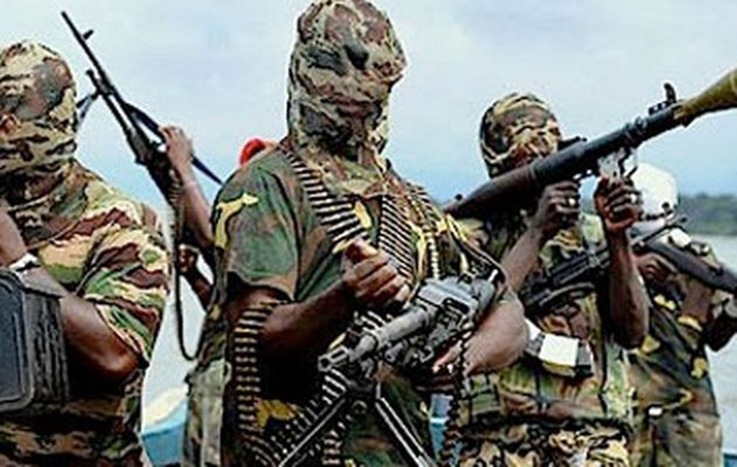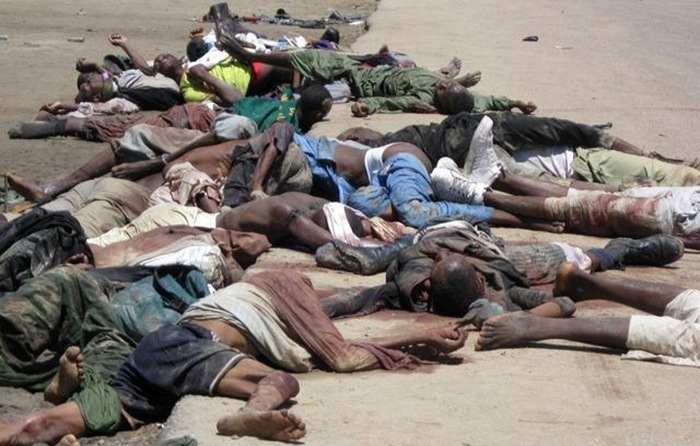Raymond Ibrahim
February 18, 2014

The New York Times has finally found a victim of Islamic aggression in Nigeria worth reporting on: homosexuals. In a big spread complete with pictures appearing last week, the NYT’s Adam Nossiter wrote “Wielding Whip and a Hard New Law, Nigeria Tries to ‘Sanitize’ Itself of Gays.”
While it’s all well and good to expose the persecution of any group, why does the NYT remain silent about the much more endemic and savage jihad to “sanitize” Nigeria of Christians—a jihad that has seen countless Christians butchered and countless churches destroyed?
A 2012 meeting of Nigerian church heads concluded that “the pattern of these killings [of Christians] does suggest to us a systematic ethnic and religious cleansing.”
Among other things in the group’s bid to cleanse the Muslim-majority north of all Christian presence, it has threatened to poison the food eaten by Christians and “to strike fear into the Christians of the power of Islam by kidnapping their women.” The group frequently storms areas where Christians and Muslims are intermingled—from villages to colleges—and singles the Christians out before slitting their throats.
In 2011 hundreds of Christians were killed and 430 churches destroyed or damaged. In 2012, 900 Christians were slaughtered. Indeed, of all Christians killed around the world in 2012, 70% were killed in the west African nation. In 2013, 612 Christians were killed and some 300 churches destroyed. The year 2014 promises to be the same. Just the other day, over 50 Christians were slaughtered by “Allahu Akbar” screaming jihadis.
Thus, from a purely demographic point of view, we may deduce that for every one man who gets exposed as a homosexual in the privacy of his own home, and killed for it, thousands of Christians expose themselves as infidels whenever they openly congregate and worship inside churches, as they do every Sunday, and get killed for it.
Based on numbers alone, then—assuming the NYT can agree that all human lives are equal, that the life of the Christian is equal in value to the life of the homosexual—the dramatically much bigger story has long been the relentless and genocidal jihad on Nigeria’s millions of Christians.
But of course, it’s not surprising that the NYT in general, reporter Adam Nossiter in particular, are biased concerning whose plight to highlight. The NYT and Nossiter are the very ones who, on December 25, 2011—the day after Boko Haram bombed several churches during Christmas Eve services, leaving some 40 dead—published a spread equivocating the truth concerning the Muslim persecution of Christians in the African nation.

Then, on Christmas Day, 2011, the NYT’s Nossiter declared:
The sect, known as Boko Haram, until now mostly targeted the police, government and military in its insurgency effort, but the bombings on Sunday represented a new, religion-tinged front, a tactic that threatens to exploit the already frayed relations between Nigeria’s nearly evenly split populations of Christians and Muslims…(emphasis added).
“Until now”? The fact is Boko Haram had been terrorizing and killing Nigerian Christians and destroying their churches several years before the 2011 Christmas church bombings. Indeed, Christmas Eve 2010—one year to the day before the 2011 Christmas Eve church attacks—Boko Haram bombed several churches, killing 38 Christian worshippers.
Thus Nossiter’s characterization of the 2011 attacks as “represent[ing] a new, religion-tinged front” is not only inaccurate but unconscionable.
Moreover, whereas the NYT’s Nossiter asserted that there are “already frayed relations” between Nigeria’s Christians and Muslims, he talks of no “frayed relations” between Muslims and homosexuals: he correctly knows that the “fraying” comes from one direction.
And it’s the same concerning Nigeria’s Muslims and Christians—the “fraying” comes from one direction. Yet, due to Nossiter’s prevarications, the reader is left with the impression that Nigeria’s Christians and Muslims are equally motivated by religious hostility—even as one seeks in vain for Christian terror organizations that bomb mosques in Nigeria every Friday to screams of “Christ is Great!”
When talking about Boko Haram’s jihad on Christians, the NYT’s Nossiter managed to insert another mainstream media favorite: the “poverty-causes-terrorism” meme: “The sect’s attacks [on Christian churches] have been further bolstered by festering economic resentment in the impoverished and relatively neglected north, which has an exploding birthrate, low levels of literacy and mass unemployment.”
Needless to say, when writing about the persecution of homosexuals, “festering economic resentment in the impoverished and relatively neglected north”—precisely where homosexuals are most persecuted—is never cited as a contributing factor.
Such are the ways that “reality” is created or evaded by the mainstream media and, from there, to the unsuspecting masses of the West. The script must always prevail—reality be damned.
